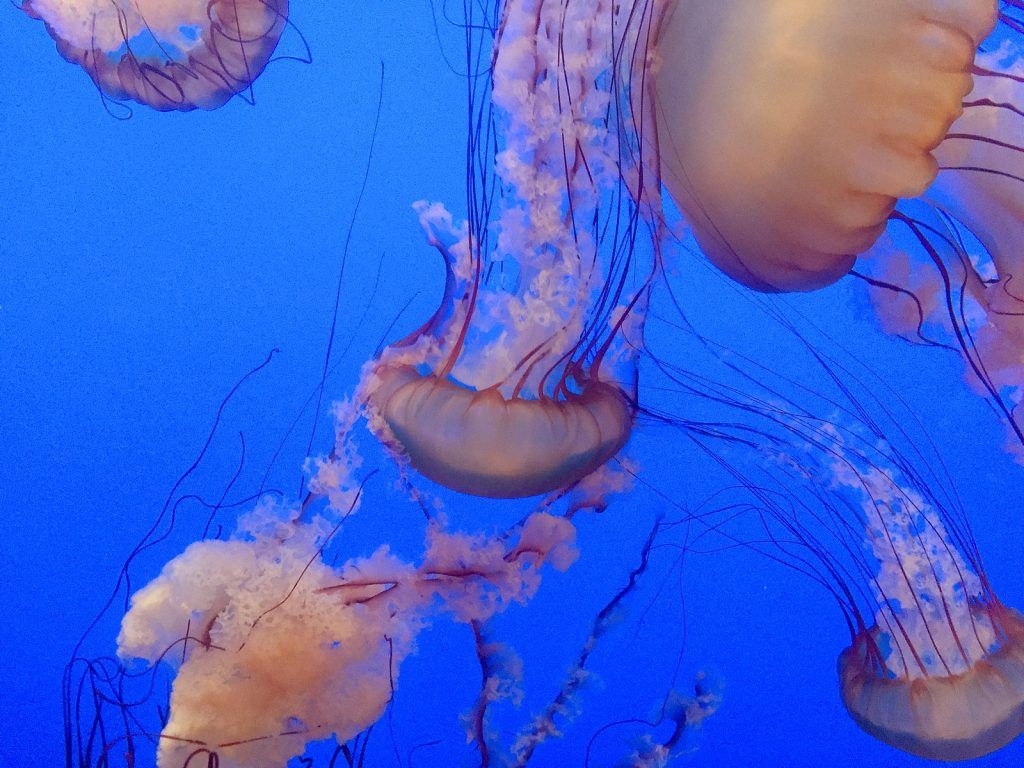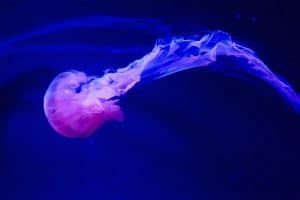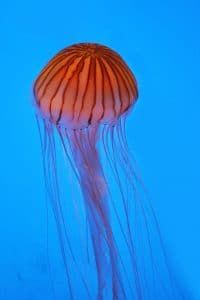Jellyfish attack nuclear power plant. Again.
By Susan D’Agostino | October 28, 2021
 Sea nettle jellyfish swimming at Monterey Bay Aquarium in Monterey, CA. Credit: Photollama. Accessed via Wikimedia Commons. CC BY-SA 4.0.
Sea nettle jellyfish swimming at Monterey Bay Aquarium in Monterey, CA. Credit: Photollama. Accessed via Wikimedia Commons. CC BY-SA 4.0.
Scotland’s only working nuclear power plant at Torness shut down in an emergency procedure when jellyfish clogged the sea water-cooling intake pipes at the plant, according to the Scotland Herald this week. Without access to cool water, a nuclear power plant risks overheating. The intake pipes can also be damaged, which disrupts power generation. And ocean life that gets sucked into a power plant’s intake pipes risks death.

The threat these gelatinous, pulsating, umbrella-shaped marine animals pose to nuclear power plants is neither new nor unknown. (Indeed, the Bulletin reported on this threat in 2015.) Nuclear power plant closures—even temporary ones—are expensive. To protect marine life and avert power plant closures, scientists are exploring early warning system options. For example, researchers at Cranfield University in the United Kingdom launched a project earlier this year to determine whether drones may be used to provide estimates of jellyfish locations, amounts, and density.
“The successful operation of [beyond visual line of sight drones] will enable us to detect threats from marine ingress at an earlier state and prevent disruption to the power plant,” Monica Rivas Casado, a senior lecturer in environmental monitoring at Cranfield, said. In the United Kingdom, 20 percent of electricity is nuclear, a percentage roughly equaled in the United States, compared with approximately 10 percent globally.
Blooms of translucent jellyfish with their trailing, stinging tentacles are sometimes described as “invasions” because they often emerge en masse in way that appears sudden. Still, determined observers may find early clues of a jellyfish bloom. Spotting jellyfish swarms by way of drones requires balancing recognition accuracy with recognition speed—at least if the goal is to take preventative action to avoid nuclear power plant disruption. Scientists have been at work developing algorithms that foster this balance, including one study that delivered results within a desirable timeframe and over 90 percent accuracy.
In another early-detection effort, scientists have investigated the potential for acoustic characteristics of these sea creatures to detect their numbers, density, and threat level. The creatures’ underwater undulations create sounds—known as “echo energy” or “acoustic scatterings”—that give them away, as long as humans are willing to listen.
The clash between gelatinous jellyfish and hulking nuclear power plants has a long history. These spineless, brainless, bloodless creatures shut down the Torness nuclear power plant in 2011 at a cost of approximately $1.5 million per day, according to one estimate. Swarms of these invertebrates have also been responsible for nuclear power plant shutdowns in Israel, Japan, the United States, the Philippines, South Korea, and Sweden.

Humans have unwittingly nurtured the adversarial relationship between jellyfish and nuclear power plants. That is, human-induced climate change has raised ocean water temperatures, setting conditions for larger-than-usual jellyfish populations. Further, the relatively warm water near nuclear power plant discharge outlets may attract jellyfish swarms, according to one study. Also, pollution has lowered oxygen levels in sea water, which jellyfish tolerate more than other marine animals, leading to their proliferation.
Some look at jellyfish and see elegant ballerinas of the sea, while others view them as pests. Either way, they are nothing if not resilient. Jellyfish are 95 percent water, drift in topical waters and the Arctic Ocean, and thrive in the ocean’s bottom as well as on its surface. Nuclear power plant operators might take note: Older-than-dinosaur jellyfish are likely here to stay.
Editor’s note: An earlier version of this article misplaced the words “this week” in the first sentence. This has been corrected.
Together, we make the world safer.
The Bulletin elevates expert voices above the noise. But as an independent nonprofit organization, our operations depend on the support of readers like you. Help us continue to deliver quality journalism that holds leaders accountable. Your support of our work at any level is important. In return, we promise our coverage will be understandable, influential, vigilant, solution-oriented, and fair-minded. Together we can make a difference.















The obvious solution is to build floating nuclear plants. Russia is currently building several for use in the Arctic Ocean and of course our Nuclear Navy has been building them for 75 years. No jellyfish problems when you can move the power plant around.
Not so good a solution ..a small accident and nuclear material is spread around the entire planet in the ocean. Bad idea..
I am a long-time nuclear power plant operator. Yes cooling water is very important. But the comment, “See Fukushima…” is inaccurate and unnecessarily inflammatory. They had too much cooling water in the form of a tsunami. What they didn’t have was essential power for pumps used to cool the reactor. Having jellyfish clog your intake is serious but it can lead to a CONTROLLED shutdown when recognized. Very different circumstances.
Why can’t marine populations that eat jellyfish be supported nearby? It seems like a natural solution to the problem. Creating a sea turtle refuge around the plant for instance could theoretically prevent the problem altogether.
The article stated that the oxygen levels have decreased due to pollution. Number one, I’m not sure how well sea turtles tolerate that, but what would be even worse would be to create a sea turtle refuge. Sea turtles are often suffocated and killed due to plastic bags in the oceans, because they look like floating jellyfish. If there’s a lot of pollution around, i’m not sure purposely placing turtles in those living conditions would be a good idea.
How small are the jelly fish? I would imagine putting a filter or seive guard, or some type of mesh material, on the intake pipes would be a good solution?
Perhaps a series of filters, to prevent clogging.
So why don’t they use simple electronic magnetic pulses under water and some form of negative energy to avert them. There must be some predators that you could promote I. Those areas and just find away dispose them. Nuclear clean energy is a a far more important concern then a few thousand jelly fish.
Very good. You would think that developers/operators would have anticipated such problems (mussels are another story) and have procedures in effect. Ah, how naive of me, profit before safety, of course.
This is a biased inaccurate anti-nuclear scare article. Nuclear plants have multiple safety cooling systems so there was no nuclear danger from the jellyfish. The jellyfish impacted the non-nuclear steam condensers outlet temperature environmental protection limits. There are no nuclear power plants in Israel nor Philippines.
Maybe it is not by accident, and they are trying to tell us something 🙂